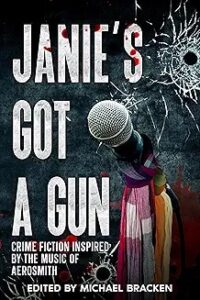 by Avram Levinsky
by Avram Levinsky
At a recent crime fiction conference, I heard a well-established writer explain that when contributing to music-inspired anthologies, all you need to do is match the title.
I cringed.
Luckily, editor Michael Bracken demanded much more of the authors contributing to Janie’s Got a Gun: Crime Fiction Inspired by the Music of Aerosmith, and I believe we delivered.
Before describing my own approach to writing for the anthology, I’d like to explore the stories of four outstanding authors who drew heavily from the music and to great effect.
The best music-inspired stories capture the mood and tone of the song. John M. Floyd did this masterfully in “Hole in My Soul,” based on the Aerosmith hard-rock ballad. The song’s mood is despondent, and its tone is theatrical. Floyd puts the reader in the head of a despondent first-person narrator and quickly paints a world theatrically saturated with crime and imminent danger. There are Easter eggs, hidden references to the song, but in this case, they also contribute to the central mood. It’s a captivating work of fiction.
Mary Dutta’s “Bitch’s Brew” captures the emotional essence of the song beautifully and in very creative ways. In this story, a woman near the tail end of a divorce runs a small business, the Bitch’s Brew coffee shop, next to the business run by her estranged husband’s lover, the Briar Patch flower shop. Moreover Zoe, Dutta’s soon to be divorced, close-third-person narrator, embodies all the anger and seedy resentment present in the song. Once again, the world the two women inhabit is, like the song, theatrical. It has emotional truth, but it goes well beyond realism in a way that makes the pages fly.
One of the hallmarks of a prototypical Aerosmith hit song is contrast, something that distinguishes them from many of their hard-rock contemporaries. “Livin’ on the Edge,” Adam Meyer’s song of choice, has a subdued, lamenting verse but a hard-hitting chorus. The story opens with Meyer’s two central characters both metaphorically and physically at the edge of a precipice. Both the lamenting verse and the hard-hitting chorus are well represented as the story evolves. The contrast serves the story every bit as well as it serves the song. There are also subtle themes from the lyrics reflected in the plot, and, of course, some well-crafted Easter eggs. It’s a great read.
In the anthology’s titular story, Joseph S. Walker establishes high emotional and material stakes in the first sentences. As details emerge, he weaves a captivating plot based, in part, on events that are strongly implied in the lyrics. It feels as if he is telling the story that Steven Tyler and Tom Hamilton might have envisioned subconsciously when they wrote the tune. Not everyone can pull this off. Editor Michael Bracken warns prospective contributors against retelling the events of the lyrics. It can quickly constrain the author rather than inspiring.
 My story in the anthology is “Last Child.” I requested it, not because the title brought story ideas to mind, but because I’ve always loved the tune. Though I haven’t asked them, I suspect many of my fellow authors sought out songs based on similar considerations.
My story in the anthology is “Last Child.” I requested it, not because the title brought story ideas to mind, but because I’ve always loved the tune. Though I haven’t asked them, I suspect many of my fellow authors sought out songs based on similar considerations.
The tune has a soft rubato introduction that transitions into an infectious boogie-woogie verse and then the more sustained refrain of the chorus, “home sweet home.” The lyrics to the verses are also quite infectious. They hint of a contrast between city living and country living, but they’re fairly abstract and filled with disjointed imagery.
I still searched for a point of emphasis or a theme when I researched one line I didn’t fully understand, something about J Paul Getty and his ear. That was when I first learned of one of the most heinous crimes of the seventies. In 1973, three years before “Last Child” and Aerosmith’s Rocks album were released, John Paul Getty III, grandson of one of the world’s richest tycoons, was kidnapped outside of Rome. At one point during his five-month ordeal, the kidnappers sent the family his severed ear as proof of his captivity.
I found that crime so upsetting that it eclipsed any other notions I’d considered. I decided to create a different kidnapping of a different heir to a different fortune using a few choice details from the true crime.
To capture some of the city versus country tension in the lyrics, I chose to set the story in Massachusetts. Worcester is very much a city, but it’s located in a largely rural part of the state. It’s also someplace I have some cultural familiarity with.
I chose to have the story’s protagonist first meet the rich heir at a musical event that occurred in 1981. That year, the Rolling Stones recorded at a farm outside of Worcester, and they played one mobbed concert at a relatively small bar downtown. I thought this scene might tie things together in a few ways. First, Aerosmith has always been strongly influenced by the Stones, so by describing a musical event involving the Stones, I hoped to capture some of Aerosmith’s vibe. Second, I hoped to evoke some of the Getty mystique because the younger generation of that family were known to associate with the Stones. I wanted to establish the story’s heir and possible kidnapping victim as a rich, connected partier. Finally, I wanted to breathe some life into the setting by contrasting an outlier event with twentieth-century Worcester’s identity as a city well past its prime.
Since I based a large part of my story on a very small part of the lyrics, I worked extra hard to bring in more phrases as Easter eggs, twelve of which ended up in the final manuscript.
It was a great privilege to write crime fiction inspired by one of rock and roll’s most enduring and most revered groups.
It’s my sincere hope that readers enjoy the anthology and sense the mindfulness, the respect, and the love Michael Bracken and all the authors brought to the project.
A recovering musician with one gold record on his living room wall and countless unsold records in his attic, Avram Lavinsky has been shortlisted for awards including the Brooklyn Nonfiction Prize, the Al Blanchard Award for New England’s best crime story, and twice for the Killer Nashville Claymore Award. His crime fiction has appeared in Best New England Crime Stories, The Best Mystery Stories of the Year, and numerous other publications. He’s also earned starred reviews from the nation’s toughest critics, his three teenage sons, although not often.
Janie’s Got a Gun: Crime Fiction Inspired by the Music of Aerosmith, published by White City Press, is available with free worldwide shipping available, no minimum purchase required when purchased through the website.

This is the first review or post in a long time that compelled me to buy an anthology (I’m on a strict budget right now and had to turn off the seductive “one-click”). I have bought so many for one story and then most of the rest of the book felt like a waste of money, but you convinced me, compelled me! Great post.
Wow, Avram. Aerosmith-song mood in the telling of a kidnapping. Brilliant! Best of luck with the JANIE’S GOT A GUN Anthology. It sounds rocking ( ;
Thanks so much for the kind words, Pam.